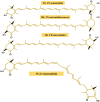Recent progress in practical applications of a potential carotenoid astaxanthin in aquaculture industry: a review
- PMID: 36607534
- PMCID: PMC10927823
- DOI: 10.1007/s10695-022-01167-0
Recent progress in practical applications of a potential carotenoid astaxanthin in aquaculture industry: a review
Abstract
Astaxanthin is the main natural C40 carotenoid used worldwide in the aquaculture industry. It normally occurs in red yeast Phaffia rhodozyma and green alga Haematococcus pluvialis and a variety of aquatic sea creatures, such as trout, salmon, and shrimp. Numerous biological functions reported its antioxidant and anti-inflammatory activities since astaxanthin possesses the highest oxygen radical absorbance capacity (ORAC) and is considered to be over 500 more times effective than vitamin E and other carotenoids such as lutein and lycopene. Thus, synthetic and natural sources of astaxanthin have a commanding influence on industry trends, causing a wave in the world nutraceutical market of the encapsulated product. In vitro and in vivo studies have associated astaxanthin's unique molecular features with various health benefits, including immunomodulatory, photoprotective, and antioxidant properties, providing its chemotherapeutic potential for improving stress tolerance, disease resistance, growth performance, survival, and improved egg quality in farmed fish and crustaceans without exhibiting any cytotoxic effects. Moreover, the most evident effect is the pigmentation merit, where astaxanthin is supplemented in formulated diets to ameliorate the variegation of aquatic species and eventually product quality. Hence, carotenoid astaxanthin could be used as a curative supplement for farmed fish, since it is regarded as an ecologically friendly functional feed additive in the aquaculture industry. In this review, the currently available scientific literature regarding the most significant benefits of astaxanthin is discussed, with a particular focus on potential mechanisms of action responsible for its biological activities.
Keywords: Antioxidant; Astaxanthin; Disease resistance; Immune system; Pigmentation; Stress.
© 2023. The Author(s).
Conflict of interest statement
The authors declare no competing interests.
Figures






Similar articles
-
Astaxanthin: a review of its chemistry and applications.Crit Rev Food Sci Nutr. 2006;46(2):185-96. doi: 10.1080/10408690590957188. Crit Rev Food Sci Nutr. 2006. PMID: 16431409 Review.
-
"Therapeutic uses of natural astaxanthin: An evidence-based review focused on human clinical trials".Pharmacol Res. 2021 Apr;166:105479. doi: 10.1016/j.phrs.2021.105479. Epub 2021 Feb 4. Pharmacol Res. 2021. PMID: 33549728 Review.
-
Determination of astaxanthin stereoisomers and colour attributes in flesh of rainbow trout (Oncorhynchus mykiss) as a tool to distinguish the dietary pigmentation source.Food Addit Contam. 2006 Nov;23(11):1056-63. doi: 10.1080/02652030600838399. Food Addit Contam. 2006. PMID: 17071507
-
Dietary values of astaxanthin and canthaxanthin in Penaeus monodon in the presence and absence of cholesterol supplementation: effect on growth, nutrient digestibility and tissue carotenoid composition.Br J Nutr. 2012 Jul 14;108(1):80-91. doi: 10.1017/S0007114511005423. Epub 2011 Dec 6. Br J Nutr. 2012. PMID: 22142867 Clinical Trial.
-
Haematococcus pluvialis as a Potential Source of Astaxanthin with Diverse Applications in Industrial Sectors: Current Research and Future Directions.Molecules. 2021 Oct 27;26(21):6470. doi: 10.3390/molecules26216470. Molecules. 2021. PMID: 34770879 Free PMC article. Review.
Cited by
-
Nutritional Benefits of Lycopene and Beta-Carotene: A Comprehensive Overview.Food Sci Nutr. 2024 Oct 16;12(11):8715-8741. doi: 10.1002/fsn3.4502. eCollection 2024 Nov. Food Sci Nutr. 2024. PMID: 39619948 Free PMC article. Review.
-
Astaxanthin in cancer therapy and prevention (Review).Biomed Rep. 2025 Feb 14;22(4):66. doi: 10.3892/br.2025.1944. eCollection 2025 Apr. Biomed Rep. 2025. PMID: 40017498 Free PMC article. Review.
-
Effects of Dietary β-Carotene Supplementation on Growth Performance, Biochemical Indices, Hemato-Immunological Parameters, and Physio-Metabolic Responses of the Oriental River Prawn (Macrobrachium nipponense).Aquac Nutr. 2025 Mar 25;2025:5184405. doi: 10.1155/anu/5184405. eCollection 2025. Aquac Nutr. 2025. PMID: 40170835 Free PMC article.
-
Astaxanthin Alleviates Aflatoxin B1-Induced Oxidative Stress and Apoptosis in IPEC-J2 Cells via the Nrf2 Signaling Pathway.Toxins (Basel). 2023 Mar 21;15(3):232. doi: 10.3390/toxins15030232. Toxins (Basel). 2023. PMID: 36977123 Free PMC article.
-
Transcriptome Analysis Reveals the Molecular Mechanism Involved in Carotenoid Absorption and Metabolism in the Ridgetail White Prawn Exopalaemon carinicauda.Animals (Basel). 2025 May 1;15(9):1314. doi: 10.3390/ani15091314. Animals (Basel). 2025. PMID: 40362129 Free PMC article.
References
-
- Ahmadi M, Bazyar A, Safi S, Ytrestøyl T, Bjerkeng B. Effects of dietary astaxanthin supplementation on reproductive characteristics of rainbow trout (Oncorhynchus mykiss) J Appl Ichthyol. 2006;22:388–394. doi: 10.1111/j.1439-0426.2006.00770.x. - DOI
-
- Alishahi M, Karamifar M, Mesbah M. Effects of astaxanthin and Dunaliella salina on skin carotenoids, growth performance and immune response of Astronotus ocellatus. Aquacult Int. 2015;23:1239–1248. doi: 10.1007/s10499-015-9880-0. - DOI
Publication types
MeSH terms
Substances
LinkOut - more resources
Full Text Sources
Medical

